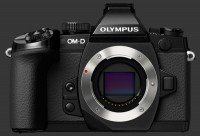Olympus OM-D E-M1 Review
Olympus OM-D E-M1 Performance - How well does it take pictures?
Performance starts with image quality, which is the criteria used as the foundation of our digital camera ratings. Ergonomic issues may get in the way, but in the end, image quality counts the most. For an ILC, image quality greatly depends on the lens used. While color, noise, exposure and dynamic-range are properties of a camera, distortion, vignetting and chromatic aberrations are properties of the lens. Sharpness and contrast depend on the weakest link. That is, a camera cannot capture more details than a lens lets through. Conversely, it is quite possible for a lens to transmit more details than a sensor can capture.
Image Noise & Details
The Olympus OM-D E-M1 delivers outstanding image-quality for a Micro Four-Thirds camera, matching the E-M5. Like its predecessor, it even bests a number of current cameras with APS-C sensors. The gap in image-quality between Micro Four-Thirds and other mirrorless systems therefore remains unnoticeable for common print sizes as the latest generation of APS-C sensors have not improved either.

Image noise is extremely low until ISO 800 and barely there at 1600 where it remains usable for relatively large prints. ISO 3200 shows visible noise with has a slight effect on the finest details. At ISO 6400, fine details get eaten by noise and maximum print size is affected. On 12" x 9" prints, ISO 6400 remains extremely usable with fine noise only visible upon close inspection.
ISO 12800 shows significant noise with fine details gone. This makes noisy mid-size prints, yet completely usable 4" x 6" ones. ISO 25600 is surprisingly usable for small prints and even makes mid-size prints with recognizable contents.
There are three levels of noise-reduction available. NR can also be turned off entirely which avoids increased softness at high sensitivities. Best results are obtained with Noise-Reduction turned off and Sharpness at zero. Anything higher shows clear sharpening artifacts on this camera which does not have an anti-alias filter.
Color & White Balance
The OM-D E-M1 improves color accuracy compared to its predecessor. Natural style delivers reasonable colors. Still, the red channel always remains too high. Default Saturation is punchy yet not overdone. Dialing it down to -1 produces more natural results.
Automatic While-Balance is excellent. It deals well with a variety of conditions including typical indoor lighting. There are tons of options for the rare cases when AWB has difficulty or to get consistent colors between shots. Custom WB is easy to use on this camera and renders whites perfectly neutral.

Exposure
This digital camera has a respectable multi-segment metering system. Scenes which fall within its dynamic-range are exposed towards the mid-tone which makes them look natural. High contrast-scenes are rendered brightly which causes more highlight clipping than usual. General over-exposure though is quite rare. This is the only area where the E-M5 performs better. It is, however, easy to tune exposure of the OM-D E-M1 and get improved results.
The E-M1 has a superb latitude for scenes of varying dynamic-range. Tone-curves are adjustable separately for shadows and highlights. Changes are even visible on the LCD and EVF, something which the E-M5 cannot do. A preview of HDR capture is even possible with the Expand Live-View Dynamic-Range setting enabled.
Auto Focus
The OM-D E-M1 has a fast Contrast-Detect autofocus system. When mirrorless digital cameras were launched, this is where they lagged the most behind DSLRs and it is great to see that Olympus has truly improved in that area.
The Olympus OM-D E-M1 can focus quickly and accurately under typical conditions. Autofocus speed compares to a mid-range DSLR in good light and is just a little slower in low-light. Focus accuracy is extremely high and this digital camera rarely confirms focus incorrectly. Contrast-Detect AF never suffers from front or back focus issues, which is why no calibration is needed.
With most Micro Four-Thirds lenses, focus is done via a fly-by-wire ring around the lens-barrel. The E-M1 keeps up well with no perceptible lag. In DMF mode, a slight turn of the focus-ring shift into manual focus. Because the ring is fly-by-wire, the E-M1 can reverse the direction for focusing except for those few lenses with a mechanical focus-ring.

New to this Olympus mirrorless is a 37-point Phase-Detect AF system. It is only enabled automatically when the E-M1 detects an attached Four-Thirds lens. No such lens was available for review and hence the performance of this is untested.
Speed
The E-M1 is a rather responsive digital camera. This mirrorless manages a fast 10 FPS continuous drive, just one FPS more than the E-M5. Very few DSLRs can shoot that fast because they need tougher shutter curtains and mirror mechanisms.
In use, the Olympus OM-D E-M1 rarely holds back the photographer. Buttons, dials and the eye-start sensor all respond instantly. The following measurements characterize its performance:
- Power-On: 1½ second. Average.
- Power-On to First-Shot: 2 seconds. Average too.
- Autofocus: ¼s on good to moderate light. Rarely more than ½s, even in low light. Excellent.
- Shutter-lag: Nearly instant with just over ¼s blackout. Quite good.
- Shot-to-shot: Just over ½s. Impressive.
- Playback: ½s to enter, instant to exit. Excellent.
- Power-Off: Nearly instant second. Very good.
- Video: Instant to start and stop but clips the last second.
With numbers like this, the Olympus E-M1 is an excellent performer. It does particularly well with the important numbers, including shutter-lag, autofocus and shot-to-shot speed. For video, it starts recording instantly which is fantastic. Just wait an extra second before stopping because that last one gets unfortunately lost.
The 10 FPS continuous drive with focus locked on the first frame works incredibly well. The Olympus OM-D E-M1 keeps shooting at a consistent pace and manages to keep the view of the EVF or LCD close to the action. This makes the Olympus OM-D E-M1 suitable for action photography, a rarity among mirrorless cameras.
The Olympus OM-D E-M1 is powered by a proprietary Lithium-Ion battery which provides 350-shots per charge with 50% flash using the supplied add-on flash which is powered by the camera. This is below average among mirrorless yet should be enough for a day of shooting. Performance can be extended by not using the supplied flash.
Olympus OM-D E-M1 Conclusion

The Olympus OM-D E-M1 is truly one of the most compelling mirrorless cameras yet. Its combination of image-quality and performance matches advanced DSLRs in a more compact yet highly ergonomic form-factor. As the successor of the OM-D E-M5, the E-M1 features an improved ultra-high resolution 2.4 megapixels 0.5" EVF in a freezeproof body which incrementally surpasses the performance of its predecessor.
Image quality is top-notch with low image noise until ISO 1600 and still makes usable images up to 12800 for mid-size prints and 25600 for small ones. Exposure and white-balance are excellent with only color accuracy being somewhat off. This puts the E-M1 close to mirrorless cameras with larger APS-C sensors.
The speed of the E-M1 is class-leading in nearly all aspects. The Contrast-Detect AF system is just as fast as the majority of DSLRs and delivers a solid performance when light is low. The 10 FPS continuous drive is the most usable of any mirrorless camera since the EVF and LCD manage to keep up. There is virtually no shutter-lag and only a short black-out time between frames.
Video performance is almost without issues. Output quality is high and the video starts recording instantly and previews framing correctly. Even continuous autofocus with an MSC lens keeps up well without much back-and-forth jitter. The only glitch is a second cut-off from the end of video clips.
The Olympus OM-D E-M1 is incredibly customizable. It lets photographers take control and improve the interface considerably from its default setup. This camera is an excellent tool for a wide range of photographic subjects. It rarely gets in the way and delivers outstanding image-quality.
 |
Please Support Neocamera
All information on Neocamera is provided free of charge yet running this website is a huge endeavor. Purchases made via affiliate links found throughout the site help keep it running and up-to-date. There is no additional cost to you, so please consider buying via these links to our affilates:
If you found any information on this site valuable and did not purchase via our affiliate links, please considering donating via PayPal:
Any amount will be greatly appreaciated. Thank you for your support!
Olympus E-M1 Highlights

Sensor-Size: 17 x 13mm

Actual size when viewed at 100 DPI
| 16 Megapixels Mirrorless | ISO 100-25600 |
| Micro Four-Thirds Mount 2X FLM | Shutter 1/8000-60s |
| 5-Axis Built-in Stabilization, 4-Stop Improvement | Full manual controls, including Manual Focus |
| 0.50" Built-in EVF 2.4 Megapixels (0.74X) | Custom white-balance with 2 axis fine-tuning |
| Automatic Eye-Start sensor | Spot-Metering |
| 2 Axis Digital Level | Hot-Shoe |
| Weatherproof down to -10C | Stereo audio input |
| Built-in Dust Reduction | Lithium-Ion Battery |
| 10 FPS Drive, 95 Images | Secure Digital Extended Capacity |
| 1920x1080 @ 30 FPS Video Recording | |
| 3" LCD 1 Megapixels |
Updates
2025.01.18

Fujifilm GFX 2025 Lens Roundup
Lens Review roundup of Fujifilm GFX Medium-Format lenses. Quality, performance and handling of the GF20-35mm F/4R WR, GF30mm F/3.5 Tilt-Shift and the GF55mm F/1.7.
2024.11.18

Best 2024 Photography Gifts for Every Budget
Great gifts for photographers and photo enthusiasts selected for every budget among the best products of 2024.
2024.08.07

Eye Protection Tips for Professional Photographers
The four main considerations for professional photographers regarding eyewear.
2024.07.14

Fujifilm X100VI Review
Flagship fixed-lens compact digital camera with a 40 MP sensor and Image-Stabilization, a first for the series. Retro design featuring dual control-dials, plus direct ISO, Shutter-Speed and EC dials. Its hybrid viewfinder can switch between EVF and OVF mode.
2024.05.09

Fujifilm GFX100 II Review
Flagship 102 Megapixels Medium-Format Mirrorless Digital Camera with 8-Stop 5-Axis IBIS, 8 FPS Drive, 8K Video and 400 MP Super-Resolution capture in a weatherproof and freezeproof body with dual control-dials and dual memory-card slots.
2024.04.03

Fujifilm X-T5 Review
Newest Fujifilm flagship boasting a 40 MP APS-C sensor, 5-axis IBIS with 7-stop efficiency, 15 FPS continuous drive, 6.2K Video capture, dual control-dials and dual SDXC UHS-II slots in a sturdy weatherproof and freezeproof body.
2023.11.20

Best Digital Cameras of 2023
Find out which are the Best Digital Cameras of 2023. All the new Mirrorless Digital Cameras from entry-level to high-end professional.
2023.07.10

Fujifilm X-H2 Review
40 Megapixels APS-C Hybrid Mirrorless Digital Camera with 7-stop IBIS. Fastest shutter ever and 8K video capture. Large builtin EVF with 0.8X magnification and 5.8 MP, plus an Eye-Start Sensor. Packed with features and large number of controls in a weatherproof and freezeproof body.
2023.05.07

Sony FE 20-70mm F/4G Review
Review of the unique Sony FE 20-70mm F/4G lens. The optical zoom of this lens spans ultra-wide-angle and medium focal-length coverage, making it one of the most versatile Full-Frame lenses on the market.
2023.01.15

Huion Inspiroy Dial 2 Review
Review of the Huion Inspiroy Dial 2 tablet, a medium sized drawing surface with dual dials and customizable buttons. Connects via USB-C or Bluetooth 5.0 with Windows, Linux and Android support.
2022.12.08

How to Pack for a Photo Trip
Find out how to pack for a travel photography trip, carry your gear safely while meeting airline regulations.
2022.11.13

Best Digital Cameras of 2022
The best digital cameras of 2022. A short list of the most outstanding models in their respective categories. Choose one for yourself or as a gift.












